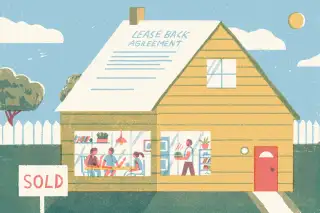Get to Know the 'Leaseback,' the Pandemic House Selling Trend Where no Move Is Required

When selling a home, getting the timing right can be tough. Selling too soon may mean scrambling to find a place to sleep. Selling too late could make it difficult to finance your next purchase. As the pandemic and recession heighten these challenges, sellers are finding workarounds.
Take Carrie Shoaf, an agent with Scenic Sotheby’s International Realty who lives in a 2,500-square-foot, four-bedroom home in Watersound Origins, a coastal community in Northwest Florida. Shoaf and her husband built the house in 2017 and are now building a new one nearby, which is scheduled for completion next summer.
“We didn't want to move twice,” said Shoaf. The couple originally planned to put their current home on the market in 2021, a couple of months before settling in their new residence. But since the onset of the pandemic, which spurred homebuying demand and interest in the neighborhood, the couple debated whether to sell early. Finally, a buyer from Indiana offered to let them remain in the home as renters until construction is finished.
This type of arrangement, in which the former homeowner rents back the property for a short duration, is known as a sale-leaseback or a holdover and is common in some markets. Scott Harris, broker with Brown Harris Stevens in New York City, estimates that up to a quarter of his transactions include leasebacks. One of the most famed leasebacks in recent years involved the Playboy Mansion, which Hugh Hefner sold for $100 million in 2016 but continued to occupy until his death about a year later.
For Shoaf, the leaseback was a perfect solution, removing the hassle of finding a short-term rental. “It was really all about the leaseback that really took us over the edge to sell,” she said. “The buyers sold a couple of businesses in Indiana. They have to transition their business for the next 12-months. It is a win-win.”
Shoaf has recently worked on two other transactions in which the owners also chose to rent back their residences. Other agents have noticed a rise in leasebacks since the onset of the coronavirus pandemic, as many sellers need additional time or cash from the sale to move out. Meanwhile, with low mortgage rates and changing housing needs spurring bidding wars across the nation, buyers may be more prone to accept a leaseback in order to beat the competition.
Lease payments
There are different ways to structure a leaseback. One approach is to subtract the fair-market rent from the seller’s proceeds, effectively decreasing what buyers pay for the property. This is what Shoaf did, prepaying her 10-month lease by accepting a lower price for the house, which is worth about $1 million.
A more traditional method is to establish monthly rent payments that help defray the new owners’ mortgage outlays. As a new homeowner, “you want the rent to at least cover your costs, and obviously try to make some money in the meantime,” said Andrew Teitel with The Agency in California.
Lease duration
Leaseback agreements rarely stretch beyond a year. Often, they last for only several weeks. Buyers who take out a mortgage may not even be able to lease the home for longer. Depending on the jurisdiction, some lenders can only permit sale-leasebacks up to two months, unless the borrower applies for a loan as an investor in a rental property. Those mortgages, though, generally carry less favorable terms. However, borrowers with long leaseback agreements can later refinance, which may allow them to designate the home as a primary residence.
Sale leasebacks can get messy for buyers-turned-landlords for other reasons. Sometimes, the former owners refuse to leave. Leasebacks often include terms to charge a rapidly escalating fee if a seller overstays their welcome. While the pandemic has prompted a slew of eviction bans shielding tenants from displacement, leasebacks are being designed to be exempt from such ordinances.
“If I'm representing the buyer, I have a statement within the contract that has the seller acknowledge that they are waiving all rights that might be afforded to them under renter protections or under COVID protections,” said Billy Rose, co-founder of real estate firm The Agency.
To hedge against the danger of uncooperative former owners-cum-renters, buyers can also hold a portion of the sale amount in escrow to be released to the sellers only when they hand over the keys to the house. While the size of the escrow depends on the property, “it is a meaningful amount of money, just enough to make sure that people are on their best behavior,”said Harris.
Home maintenance
Temporarily withholding a part of the seller’s profit also helps ensure that they take good care of the home, which should be subject to a final inspection once the leaseback expires.
During the leasing period, tenants often cover utility costs, while the new owners carry the home insurance and general maintenance, especially outdoors. “The new owner wants to make sure that the property is maintained really well,” said Sally Forster Jones of brokerage Compass in Beverly Hills, California. “They don’t want the pool turned green or the whole landscaping to be destroyed because it's quite expensive to get that back to where it was.”
Regardless of their potential snares, sale-leasebacks can provide breathing room to successfully execute a transaction, especially in a market rocked by coronavirus. “In this market, where there's so much uncertainty, it's about being creative,” said Harris.